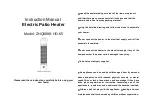
www.desatech.com
107068-01K
19
INSPECTING bURNERS
Check pilot flame pattern and burner flame pat
-
terns often.
pILOT FLAME pATTERN
Figure 23 shows a correct pilot flame pattern.
Figure 24 shows an incorrect pilot flame pattern.
The incorrect pilot flame is not touching the
thermocouple. This will cause the thermocouple
to cool. When the thermocouple cools, the heater
will shut down.
If pilot flame pattern is incorrect, as shown in
Figure 24
• turn heater off (see
To Turn Off Gas to Appli-
ance
, page 18)
• see
Troubleshooting
, page 21
Note:
The pilot flame on natural gas units will
have a slight curve, but flame should be blue and
have no yellow or orange color.
Figure 23 - Correct Pilot Flame Pattern
(Natural Gas Pilot Shown)
Figure 24 - Incorrect Pilot Flame Pattern
(Natural Gas Pilot Shown)
Thermocouple
Pilot Burner
Thermocouple
Pilot Burner
CLEANING AND
MAINTENANCE
WARNING: Turn off heater
and let cool before cleaning.
CAUTION: You must keep
control areas, burner and circu-
lating air passageways of heater
clean. Inspect these areas of
heater before each use. Have
heater inspected yearly by a
qualified service person. Heater
may need more frequent clean-
ing due to excessive lint from
carpeting, bedding material, pet
hair, etc.
WARNING: Failure to keep
the primary air opening(s) of
the burner(s) clean may result in
sooting and property damage.
ODS/pILOT AND BURNER
Use a vacuum cleaner or small, soft bristled brush
to clean.
BURNER INjECTOR HOLDER AND
pILOT AIR INLET HOLE
The primary air inlet holes allow the proper
amount of air to mix with the gas. This provides a
clean burning flame. Keep these holes clear of dust,
dirt and lint. Clean these air inlet holes prior to each
heating season. Blocked air holes will create soot.
We recommend that you clean the unit every three
months during operation and have heater inspected
yearly by a qualified service person.
We also recommend that you keep the burner
tube and pilot assembly clean and free of dust and
dirt. To clean these parts we recommend using
compressed air no greater than 30 PSI. Your local
computer store, hardware store or home center
may carry compressed air in a can. You can use a
vacuum cleaner in the blow position. If using com
-
pressed air in a can, please follow the directions on
the can. If you don’t follow directions on the can,
you could damage the pilot assembly.










































